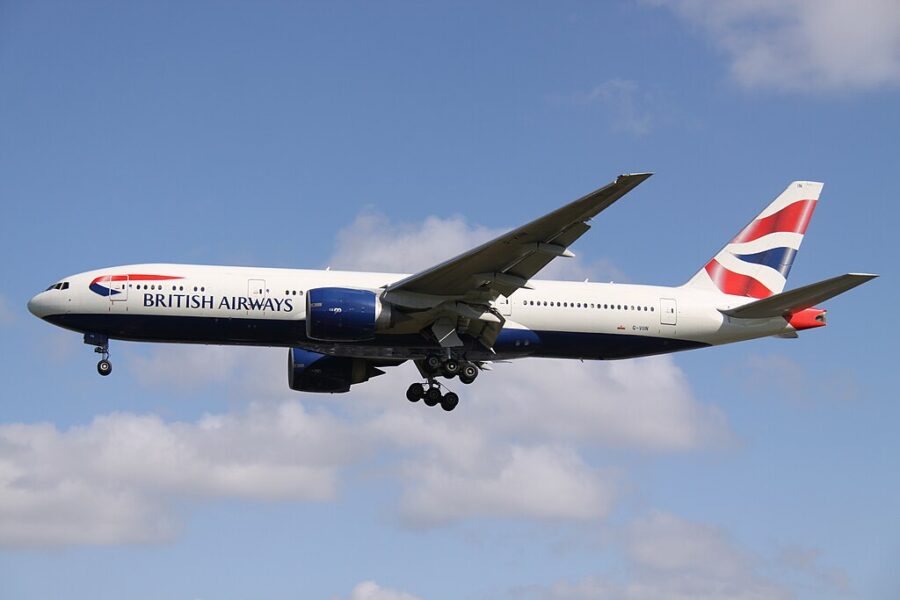British Airways Flight Brake Fire Caused by Pilot’s Control Mix-Up During Takeoff

A British Airways flight caught fire after a pilot mistakenly mixed up left and right controls during takeoff, according to a recent report from the Air Accident Investigation Branch (AAIB).
The incident occurred on June 28, 2024, when flight BA2279, bound for Vancouver, faced a major issue during its takeoff at Gatwick Airport. The co-pilot, while preparing for takeoff, mistakenly pulled back with his left hand when he should have done so with his right on the thrust levers. This simple error triggered a chain of events that led to a rejected takeoff, a brake fire, and the temporary closure of Gatwick Airport.
The Event Unfolds
At approximately 1:30 p.m., the co-pilot of the Boeing 777-200ER engaged the aircraft’s thrust levers incorrectly, applying the wrong amount of power at a critical stage of takeoff. This caused a brake fire due to excessive braking while the aircraft was traveling at 186 mph. The incident led to the diversion of 16 inbound flights and the cancellation of 23 departures from Gatwick.
Despite this serious issue, 347 passengers aboard the flight were unharmed. The FAA’s investigation confirmed that this was not the first time the airline had experienced communication or equipment failures at Newark.
Co-Pilot Error Causes Major Disruptions
The co-pilot, despite being well-rested with over 6,000 flying hours, could not identify the cause of his confusion between left and right. The action slip caused the aircraft to lose power when it needed maximal thrust to lift off. The AAIB described this event as an “action slip,” which happens when a routine action is unintentionally performed incorrectly during familiar motor sequences.
Within two seconds of the error, the co-pilot corrected his mistake, cutting the power and applying the brakes, bringing the aircraft to a safe stop. Firefighters arrived shortly after to extinguish the brake fire, which occurred on the right main landing gear.
Financial and Operational Impact
The FAA’s investigation revealed that rejected take-offs (RTOs) can be risky, and the British Airways incident added to the cost of operational disruptions. According to estimates from Eurocontrol, the cost of canceling a long-haul flight averages around £72,000. This suggests that the cost to the airline from the 23 canceled flights due to the action slip could amount to millions of pounds.
In a similar incident at Stansted Airport in 2020, a panicked cabin crew ordered an evacuation, leading to a 169-passenger emergency evacuation. This evacuation resulted in ten injuries and unnecessary panic.
The Role of Pilot Training and Technology
While the AAIB has noted that the pilot’s training was thorough and standard operating procedures were followed, the incident raises concerns about routine pilot training. The co-pilot had not recently undergone a simulator session or seat change, suggesting that the mix-up may have been due to human error in a high-pressure environment.
British Airways has emphasized its commitment to safety. A spokesperson for the airline stated, “Safety is always our highest priority, and our pilots brought the aircraft to a safe stop. We apologized to our customers, and our teams worked hard to get them on their way as quickly as possible.”
This incident at Gatwick Airport highlights the importance of continuous training, technological support, and error management systems in aviation. Even a small mistake, such as mixing up left and right, can lead to significant operational disruptions, financial costs, and safety concerns. As airlines and aviation authorities continue to address the challenges posed by human error, the implementation of enhanced training protocols and cutting-edge aviation technology will be key in preventing similar incidents in the future.
Related News: https://airguide.info/?s=British+Airways, https://airguide.info/category/air-travel-business/travel-health-security/safety/
Sources: AirGuide Business airguide.info, bing.com, yahoo.com
